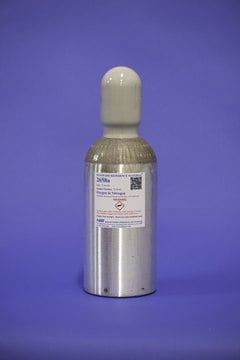428167
Chloric acid solution
35 wt. %
Synonym(s):
Chloric acid
Sign Into View Organizational & Contract Pricing
All Photos(1)
About This Item
Linear Formula:
HClO3
CAS Number:
Molecular Weight:
84.46
MDL number:
UNSPSC Code:
12000000
Recommended Products
concentration
35 wt. %
bp
>100 °C
density
1.2 g/mL at 25 °C
SMILES string
OCl(=O)=O
General description
Chloric acid solution (Chloric acid) is a strong oxidizing agent. It can be synthesized by reacting barium chlorate with dilute sulfuric acid. Chloric acid is reported to be formed during the decompostion of aqueous solution of chlorine dioxide.
Application
Chloric acid solution (Chloric acid) may be used in the synthesis of crystals of anhydrous mercurous chlorate.
Stable precursor to chlorine dioxide. Used in electrochemical production of high-purity ammonium perchlorate.
Signal Word
Danger
Hazard Statements
Precautionary Statements
Hazard Classifications
Eye Dam. 1 - Ox. Liq. 1 - Skin Corr. 1B
Storage Class Code
5.1A - Strongly oxidizing hazardous materials
WGK
WGK 3
Flash Point(F)
Not applicable
Flash Point(C)
Not applicable
Choose from one of the most recent versions:
Certificates of Analysis (COA)
Lot/Batch Number
Don't see the Right Version?
If you require a particular version, you can look up a specific certificate by the Lot or Batch number.
Already Own This Product?
Find documentation for the products that you have recently purchased in the Document Library.
Dotson, R.L.
J. Appl. Electrochem., 23, 897-897 (1993)
The Use of Chlorine Dioxide in Water Treatment.
Vincent GP, et al.
American Journal of Public Health and the nation's Health, 36(9), 1035-1037 (1946)
Anhydrous Mercurous Chlorate, Hg2(ClO3)2.
Goebbels D and Meyer G.
Zeitschrift fur Anorganische und Allgemeine Chemie, 629(14), 2446-2447 (2003)
Eagleson M.
Concise Encyclopedia Chemistry, 212-213 (1994)
Suthida Kankirawatana et al.
Journal of clinical apheresis, 22(5), 265-269 (2007-08-28)
While therapeutic plasma exchanges (TPEs) performed with 5% albumin are considered safe, concerns regarding venous access and hypocalcemic toxicity remain. We reviewed the frequency of complications during TPEs performed with 5% albumin supplemented with calcium gluconate and potassium chloride for
Our team of scientists has experience in all areas of research including Life Science, Material Science, Chemical Synthesis, Chromatography, Analytical and many others.
Contact Technical Service





